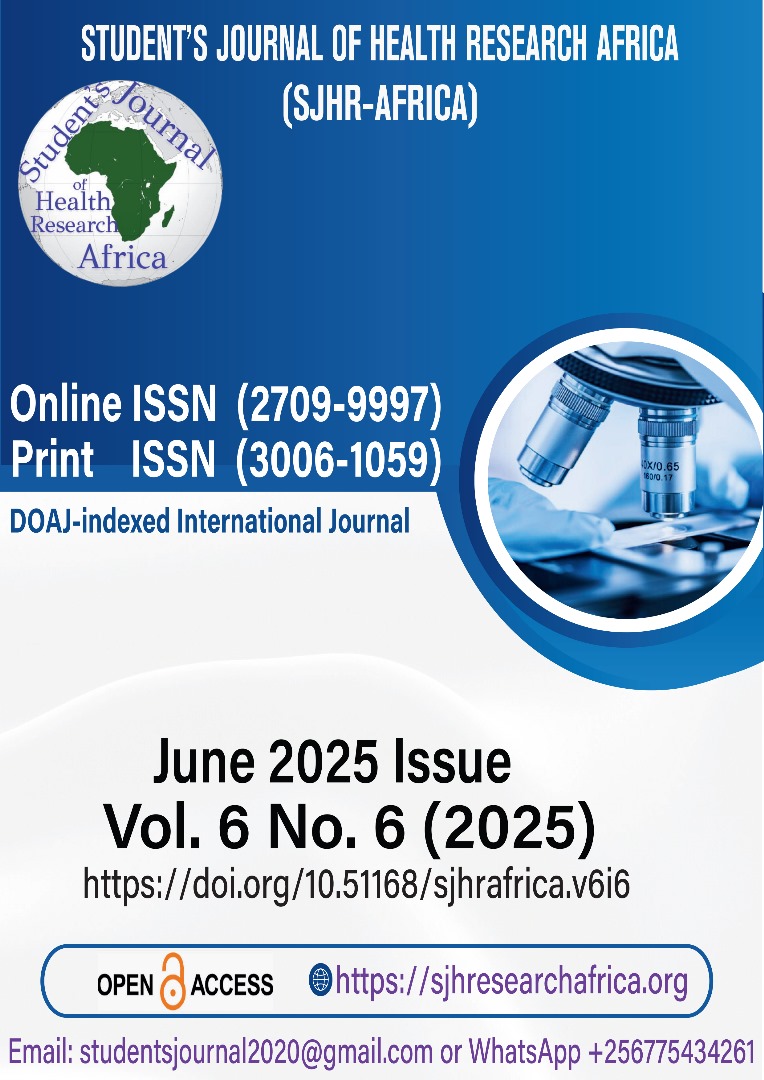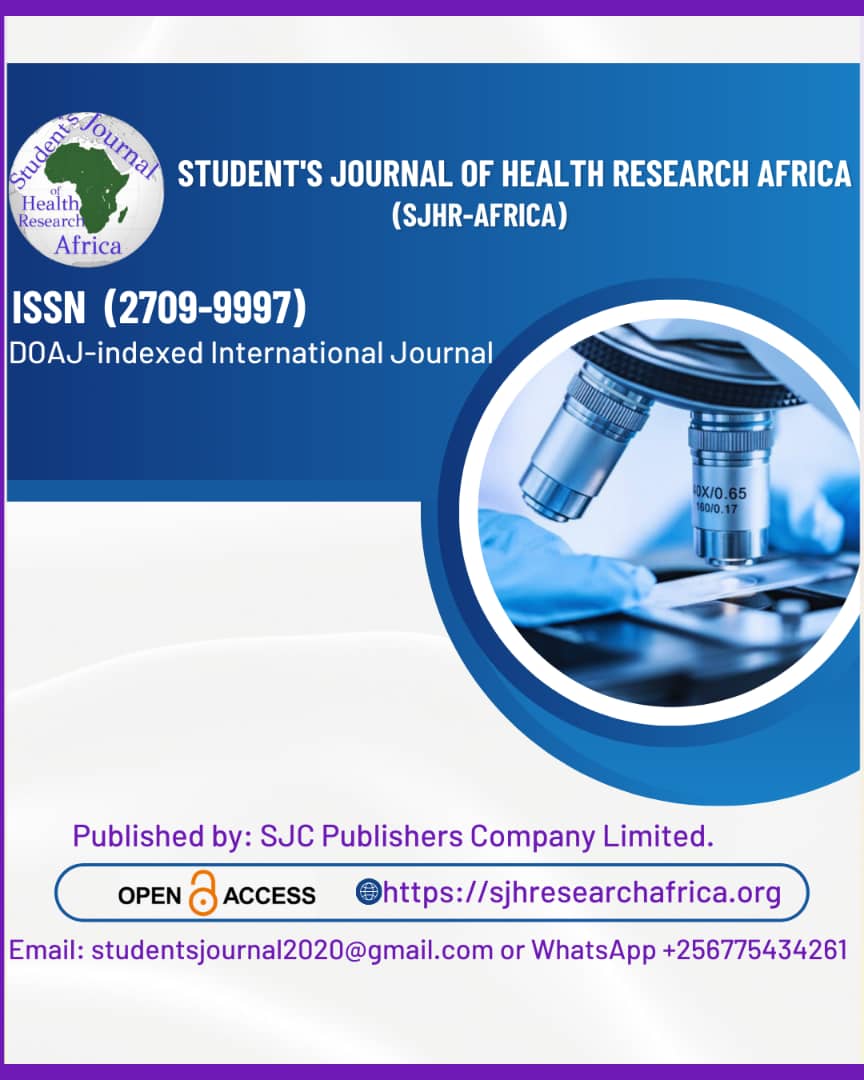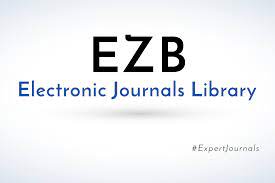A CASE-CONTROL STUDY OF CHOROIDAL THICKNESS IN PATIENTS WITH CENTRAL SEROUS CHORIORETINOPATHY: A STUDY AT RIMS, RANCHI, JHARKHAND
DOI:
https://doi.org/10.51168/sjhrafrica.v6i6.1833Keywords:
Central serous chorioretinopathy, Choroidal thickness, Optical coherence tomography, RIMS Ranchi, Case-control studyAbstract
Background
Central Serous Chorioretinopathy (CSCR) is a retinal disorder characterized by the accumulation of subretinal fluid, often linked to retinal pigment epithelium (RPE) dysfunction and choroidal hyperpermeability. Choroidal thickness, a key parameter in understanding the pathophysiology of CSCR, has been implicated in disease onset and progression. Despite extensive research, regional variations in CSCR and choroidal thickness remain underexplored, especially in Indian populations.
Objectives: This study analyzed and compared choroidal thickness in patients with CSCR and healthy controls. It also sought to investigate the relationship between choroidal thickness and disease severity.
Methods
A 12-month case-control study was conducted at RIMS Ranchi from January 2024 to December 2024, Jharkhand. The study included 50 patients diagnosed with CSCR and 50 age—and sex-matched healthy controls. Choroidal thickness was measured using Optical Coherence Tomography (OCT) in the subfoveal region and 500 μm nasal and temporal to the fovea. Descriptive statistics were used for baseline data, while t-tests and correlation analyses assessed differences and relationships between choroidal thickness and clinical parameters.
Results
CSCR patients exhibited significantly greater mean subfoveal choroidal thickness than controls (p < 0.001). Similar differences were observed in the nasal and temporal regions. A positive correlation was noted between disease duration and choroidal thickness (r = 0.46, p = 0.001), while an inverse relationship was found between choroidal thickness and best-corrected visual acuity (BCVA) (r = -0.39, p = 0.005). These findings reinforce the role of choroidal thickening in CSCR pathophysiology and its association with disease progression.
Conclusion
This study highlights the clinical relevance of choroidal thickness as a diagnostic and prognostic marker in CSCR. The findings emphasize the importance of early detection and monitoring choroidal changes to improve management and outcomes.
Recommendation
Further longitudinal and multicenter studies are recommended to validate these observations and explore therapeutic implications.
References
Imanaga, N., Terao, N., Sonoda, S., Sawaguchi, S., Yamauchi, Y., Sakamoto, T., & Koizumi, H. (2023). Relationship between scleral thickness and choroidal structure in central serous chorioretinopathy. Investigative Ophthalmology & Visual Science, 64(1), 16-16.
Xiao, B., Yan, M., Song, Y. P., Ye, Y., & Huang, Z. (2024). Quantitative assessment of choroidal parameters and retinal thickness in central serous chorioretinopathy using ultra-widefield swept-source optical coherence tomography: a cross-sectional study. BMC ophthalmology, 24(1), 176.
Imanaga, N., Terao, N., Nakamine, S., Tamashiro, T., Wakugawa, S., Sawaguchi, K., & Koizumi, H. (2021). Scleral thickness in central serous chorioretinopathy. Ophthalmology Retina, 5(3), 285-291.
Okawa, K., Inoue, T., Asaoka, R., Azuma, K., Obata, R., Arasaki, R., ... & Kadonosono, K. (2021). Correlation between choroidal structure and smoking in eyes with central serous chorioretinopathy. PLoS One, 16(3), e0249073.
Sawaguchi, S., Terao, N., Imanaga, N., Wakugawa, S., Tamashiro, T., Yamauchi, Y., & Koizumi, H. (2022). Scleral thickness in steroid-induced central serous chorioretinopathy. Ophthalmology Science, 2(2), 100124.
Loiudice, P., Pellegrini, M., Marinò, M., Mazzi, B., Ionni, I., Covello, G., ... & Casini, G. (2021). Choroidal vascularity index in thyroid-associated ophthalmopathy: a cross-sectional study. Eye and Vision, 8, 1-8.
Yoon, J., Han, J., Ko, J., Choi, S., Park, J. I., Hwang, J. S., ... & Hwang, D. D. J. (2022). Classifying central serous chorioretinopathy subtypes with a deep neural network using optical coherence tomography images: a cross-sectional study. Scientific Reports, 12(1), 422.
Liu, P., Fang, H., An, G., Jin, B., Lu, C., Li, S., ... & Jin, X. (2024). Chronic central serous chorioretinopathy in elderly subjects: structure and blood flow characteristics of retina and choroid. Ophthalmology and Therapy, 13(1), 321-335.
Fernández-Vigo, J. I., Moreno-Morillo, F. J., Shi, H., Ly-Yang, F., Burgos-Blasco, B., Güemes-Villahoz, N., ... & García-Feijóo, J. (2021). Optical coherence tomography assesses the anterior scleral thickness in central serous chorioretinopathy patients. Japanese Journal of Ophthalmology, 65, 769-776.
Funatsu, R., Sonoda, S., Terasaki, H., Shiihara, H., Mihara, N., Horie, J., & Sakamoto, T. (2023). Choroidal morphologic features in central serous chorioretinopathy using ultra-widefield optical coherence tomography. Graefe's Archive for Clinical and Experimental Ophthalmology, 261(4), 971-979.
Terao, N., Koizumi, H., Kojima, K., Kusada, N., Nagata, K., Yamagishi, T., ... & Sotozono, C. (2020). Short axial length and hyperopic refractive error are central serous chorioretinopathy risk factors. British Journal of Ophthalmology, 104(9), 1260-1265.
Downloads
Published
How to Cite
Issue
Section
License
Copyright (c) 2025 komal Kumari

This work is licensed under a Creative Commons Attribution-NonCommercial-NoDerivatives 4.0 International License.






















